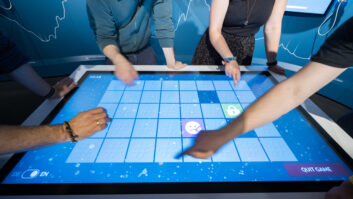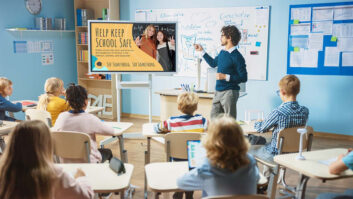Are virtual classrooms the future of education? Catherine Whitaker, CEO and head of learning at education technology company EtonX (a subsidiary of Eton College), says yes
Hi Catherine. To kick things off, tell us a little about EtonX’s Future Skills programme (FSP).
Our FSP provides live online soft skills courses for teenagers around the world. Our team works with Eton’s teachers to devise the courses and we’ve built a bespoke virtual classroom to enable students to practice and develop these skills.
Our mission is to close the global soft skills gap in young people. It’s accepted by teaching professionals that some of the most important learning experiences and development happen outside the classroom. As a consequence, EtonX is helping ambitious schools that want to supplement their programmes or that want to offer parents and students the opportunity to choose which soft skills courses would most benefit them. There isn’t a definitive globally-agreed list of vital soft skills but they generally include communication, creativity and critical thinking – as well as practical skills like interview technique, CV writing and essay writing.
Talk us through what a virtual classroom actually is.
Live video streaming advances mean participants on EtonX’s courses interact much more naturally during group discussions with each other and their tutor, while also benefiting from innovations such as virtual breakout rooms that facilitate debates among students in smaller and easily-manageable groups. In addition, EtonX’s bespoke virtual classroom uses the full functionality of the latest WebRTC protocols, which enables users to access the virtual classroom via a browser without requiring any software download. The features allow teachers to teach as if they were in a real offline classroom.
What age range is this suited towards?
Our courses target 14-20 year-olds but also students doing foundation courses at universities.
Can you talk us through the setup?
Courses are available to young people that have a PC, smartphone or tablet and a good Internet connection. We insist on headphones or earphones to ensure sound quality and we also encourage students to access the classroom using a laptop or desktop computer to ensure the quality of their connection and the stability of their video stream.
What are the current disadvantages and obstacles of traditional physical classrooms?
There are big advantages for soft skills teaching when using a virtual classroom over a physical one. The tutor can see all the students face out at once, so there is no ‘back row’, and students can see each other at all times. This is physically impossible in the real world. In our case, we typically teach our courses to groups of eight, so tutors are able to focus on each and every student’s needs.
Can it really be an improved experience?
We believe that an advanced virtual classroom can replicate a physical classroom experience – and in certain circumstances, perhaps even improve upon aspects of it.
I’ll give a couple of other examples of the important difference that a virtual classroom can make. First, we incorporate virtual breakout rooms which are more private than their real-world counterparts – they prevent students from eavesdropping on other groups to take their ideas. Second – and it may surprise some readers – when using a virtual classroom, we found that shy students are more willing to role-play because the screen acts as a distancing mechanism, making such exercises seem less threatening than they would in a physical classroom.
How do children communicate with the teacher?
Students in our classes can raise their hands virtually in one click (a little hand appears on their image) and the teacher immediately sees they have a question or a contribution to make. Students can also send a chat message to the tutor, either privately or so that the whole class can see.
Where are tutors located?
Our tutors are typically UK-based but in order to cater to every time zone, we are building up our capacity in other countries. Tutors need to be excellent educators who have the skills to tutor online effectively.
You’ve described virtual classrooms as taking a “giant leap forward”. Can you explain what you meant?
With older versions of online learning technology, the picture and sound quality was not there to enable students to practise key communication skills such as how to give a speech, assert themselves or handle a tricky conversation. That’s because video classrooms were really online lecture halls with the tutor talking to the students with limited communication between the tutor and student or between the students themselves. Today’s technology enables more effective and flexible virtual classrooms: they are humanising the technology.
Surely, part of the experience of school is interaction and meeting and collaborating with other people, isn’t it?
I agree – and a virtual classroom is a great way of getting students from different backgrounds and different places learning together. Intercultural skills are important in a globalised economy and this is a way for students who may be heading to study or work overseas to learn from their peers.
Who is this best suited for?
We think our courses are relevant to young people from different countries, cultures, schools and universities across the world that are looking to develop their soft skills. Importantly too, our virtual classrooms offer forms of interaction that are prevalent in the world of work but not normally encountered at schools, such as virtual project group discussions and conference calls.
What can be taught in a virtual classroom environment?
In a world where employers are rethinking their workforces’ needs and skills, is that if you can’t convey a great idea either verbally or in writing, or solve problems creatively as part of a team, no amount of technical education is going to make up for this gap. Research has already shown that acquiring soft skills boosts academic results: World Economic Forum (WEF) global-level analysis of academic outcomes in 2016 found that students with social and emotional learning achieve outcomes up to 11 per cent higher than those without.
Could a virtual classroom ever completely replace the need for a physical one?
I think there are lots of reasons why children go to school including the need to socialise and do physical activities and so their parents can go out to work! So no, I don’t think a complete replacement of physical classrooms will take place. A rounded education demands a balance of technical and soft skills. As a result, it will be based on different types of teaching, co-curricular activities and leadership. It’s about giving pupils the most sympathetic and enjoyable learning experiences delivered in different physical and virtual settings as the school decides.
Is there any evidence to suggest student performance has been enhanced using this method?
Most of our students come to us with limited experience of learning in a virtual classroom but they quickly get used to it and report that not only have they enjoyed the experience but it had been valuable to their skills development.
What about costs?
Our Future Skills Programme comprises eight different courses delivered over seven weeks – Making An Impact; Public Speaking; Verbal Communication; Writing Skills; Interview Skills; CV Writing; Critical Thinking; and Entrepreneurship. Each course costs $399. As well as being marketed to schools and universities, the courses can be purchased directly by individual students, parents and employers to supplement their existing learning arrangements.
Are the qualifications recognised?
EtonX courses are not designed to comply specific countries’ curricula or examination board requirements; instead, they take some of the elements of world-famous Eton College education (e.g. Verbal Communication and Entrepreneurship) and make them available as online digital courses to ambitious schools that want to expand their existing co-curricular activities.







